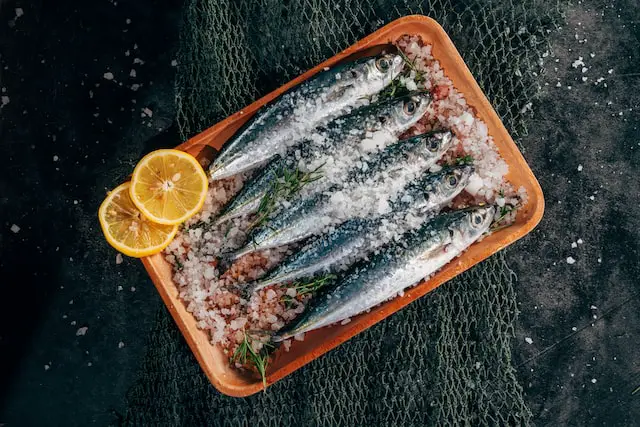Mackerel and sardines are two different types of fish that both offer a healthy source of protein. They differ in size, flavour, texture, nutrition content, and preparation methods. While sardines may be easier to find in cans and more suitable for those who prefer milder flavours, mackerel is a great choice for those looking for an oilier taste with higher levels of omega-3s.
What are sardines?
(Photo by Harris Vo on Unsplash )

Sardines are small, oily fish that are found in the Atlantic, Pacific, and Mediterranean oceans. They are an important food source for many people and are often canned or smoked. Sardines are high in protein and omega-3 fatty acids, which can help to improve heart health and reduce inflammation.
What are mackerel?
(Photo by Ben Wicks on Unsplash )

Mackerel are a type of oily fish that are high in omega-3 fatty acids. There are many different types of mackerel, but they all have a similar appearance – they are long and slim with greenish-blue backs and silver sides. Mackerel are found in temperate waters all over the world, and are popular for both commercial and recreational fishing.
Mackerel Vs. Sardines – Key differences
Mackerel and sardine are both oily fish that are popular for their nutritional benefits and delicious taste. However, there are some key differences between these two types of fish:
- Size: Mackerel are larger fish that can grow up to 2 feet long, while sardines are smaller fish that typically measure around 6 inches in length.
- Taste: Mackerel has a stronger, more pronounced flavor compared to sardines, which have a milder taste.
- Texture: Mackerel has a firmer texture with larger flakes, while sardines have a softer, more delicate texture.
- Nutritional content: Both mackerel and sardines are high in omega-3 fatty acids, which are beneficial for heart health and brain function. However, mackerel tends to be higher in omega-3s, while sardines are higher in calcium and vitamin D.
- Sustainability: Sardines are generally considered a more sustainable choice of fish, as they are smaller and reproduce more quickly than mackerel. Mackerel populations have been declining due to overfishing in some areas.
Overall, both mackerel and sardines are nutritious and delicious fish that can be enjoyed in a variety of dishes. The choice between these two types of fish may come down to personal taste, texture preference, and sustainability considerations.
The best way to cook mackerel and sardines
There are many ways to cook mackerel and sardines, but some methods are better than others. When it comes to these small fish, grilling or baking is the best way to go. Grilling or baking gives the fish a nice flavor and helps to prevent them from drying out.
When grilling mackerel or sardines, it’s important to oil the grill beforehand so that the fish doesn’t stick. You’ll also want to be careful not to overcook them – they should only be on the grill for a few minutes per side.
Baking is another great option for cooking mackerel and sardines. Simply preheat your oven to 400 degrees Fahrenheit, then place the fish on a lightly oiled baking sheet. Bake for 10-12 minutes, or until cooked through.
No matter how you choose to cook them, mackerel and sardines make a delicious and healthy meal. They’re packed with protein and omega-3 fatty acids, which are good for your heart health. So next time you’re looking for a quick and easy seafood dinner, give these little fish a try!
Recipes for mackerel and sardines
When it comes to small, oily fish, there is often confusion about the difference between mackerel and sardines. Both are excellent sources of omega-3 fatty acids, but there are some key distinctions. For starters, mackerel are larger and have a higher fat content than sardines. This means that they also have a stronger flavor. Mackerel is best cooked using methods that allow the fat to render out, such as grilling or smoking. Sardines, on the other hand, are smaller and have a delicate flavor that is best enjoyed in simple preparations, like being grilled whole or used in a fresh salsa.
So what’s the difference when it comes to recipes? Here are some ideas for recipes that highlight the unique characteristics of each fish:
Mackerel:
- Smoked mackerel pate
- Grilled mackerel with lemon and herb butter
- Spicy Korean-style mackerel
Sardines:
- Grilled sardines with olive oil and lemon juice
- Sardine pasta with tomatoes and capers
- Fresh sardine salsa
The types of mackerel
Mackerel is a common name applied to a number of different species of pelagic fish, mostly, but not exclusively, from the family Scombridae. They are found in both temperate and tropical seas. Most mackerel spawn in huge schools along coastlines and travel long distances up coastal rivers to reach their spawning grounds. After spawning they return the open sea. The word “mackerel” is derived from Old French maquerel, meaning a pimp or procurer.
The term mackerel refers to different species in different parts of the world. In North America, the term generally refers to fish from the genus Scomberomorus, such as the Atlantic mackerel (Scomberomorus maculatus), Spanish mackerel (Scomberomorus commerson), king mackerel (Scomberomorus cavalla) or cero (Scomberomorus regalis). Other members of this genus include the chub mackerels or jureles (Seriola spp.), which resemble Spanish and king mackerels; barracudinas, which have an elongated body shape; and false albacores or bonito del norte (Seriolina nigrivittata). Mackerel can also refer to fish from other families, such as Trachurus murphyi in Australia and New Zealand, Rastrelliger brachysoma in Japan and Johnius
The types of sardines
There are many types of sardines, but the most common are the Atlantic and Pacific varieties. Atlantic sardines are found in the waters off the coast of Europe, while Pacific sardines are found in the waters off the coast of North America. Both types of sardines are small, oily fish that are high in protein and low in calories.
Which is better mackerel or sardines?
Both mackerel and sardines are small, oily fish that are rich in nutrients. They are both a good source of protein, omega-3 fatty acids, and vitamins A and D. So, which is better?
Mackerel is a better choice if you are looking for a fish with more omega-3 fatty acids. One serving of mackerel has about twice as much omega-3 fatty acids as sardines. Omega-3 fatty acids are important for heart health and cognitive function. Mackerel is also a good source of vitamin B12, which is important for red blood cell production.
Sardines are a better choice if you want a fish that is lower in mercury. Mercury is a toxic metal that can build up in the body over time and cause health problems. Since sardines are smaller and lower on the food chain, they tend to have less mercury than larger fish like mackerel. Sardines are also a good source of calcium, which is important for bone health.
Both mackerel and sardines offer health benefits, so choose the one that fits your needs best.
The health benefits of mackerel and sardines
Mackerel and sardines are both oily fish that are rich in nutrients and offer a range of health benefits. Here are some of the health benefits of including mackerel and sardines in your diet:
- Heart health: Both mackerel and sardines are high in omega-3 fatty acids, which can help lower blood pressure, reduce inflammation, and lower the risk of heart disease.
- Brain function: Omega-3 fatty acids found in mackerel and sardines may also support brain function and cognitive health, particularly in older adults.
- Eye health: The omega-3 fatty acids found in these fish can also support eye health, helping to prevent age-related macular degeneration.
- Bone health: Sardines, in particular, are high in calcium and vitamin D, which are important for bone health and may help reduce the risk of osteoporosis.
- Weight management: The protein found in both mackerel and sardines can help keep you feeling full and satisfied, making them a good choice for weight management.
- Mood regulation: The omega-3 fatty acids found in these fish may also help regulate mood and reduce symptoms of depression and anxiety.
It’s important to note that these fish should be consumed in moderation, as they can also be high in mercury and other pollutants. However, incorporating mackerel and sardines into a balanced diet can offer a range of health benefits.
Which fish has the most omega-3?
There are many different types of fish that contain omega-3 fatty acids, but some fish have more omega-3 than others. Salmon, herring, and anchovies are all high in omega-3, but salmon has the most omega-3 of all three. One serving of salmon ( 3 ounces) has about 1,500 milligrams of omega-3 fatty acids.
Featured Image By – Photo by Fengyou Wan on Unsplash









